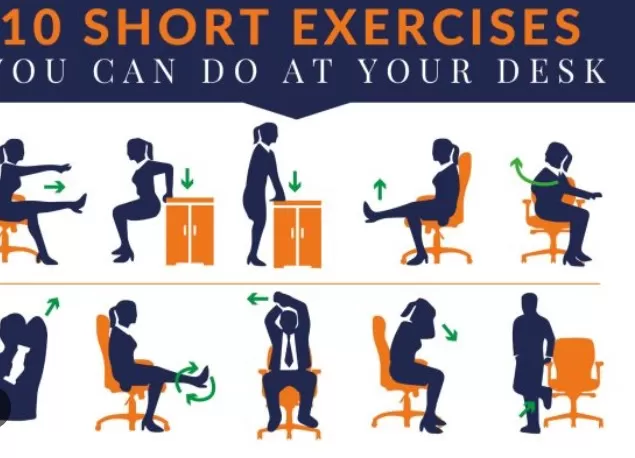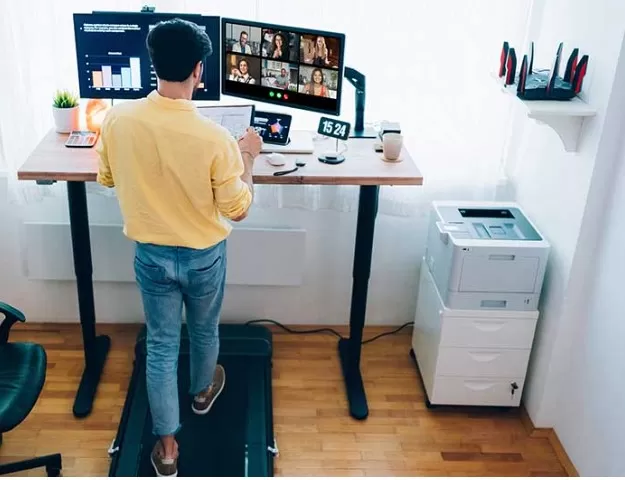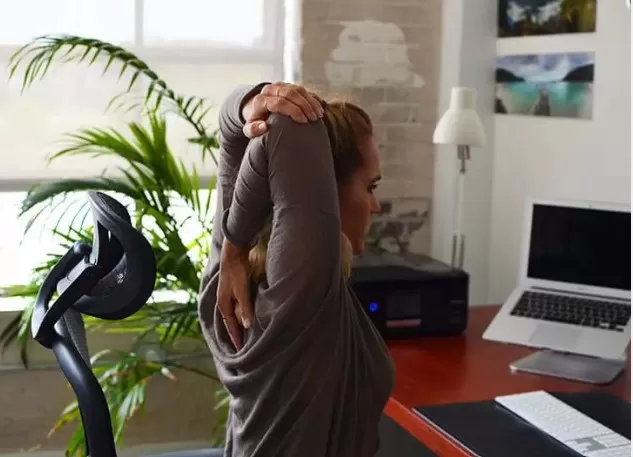Quick Desk Exercises: 10 Energizing Moves Before Meeting. Working at a desk often means prolonged periods of inactivity, leaving you longing for ways to stay active throughout the day. Spending upwards of eight hours seated can take a toll on your well-being. Fortunately, the solution lies in incorporating desk exercises into your routine.
These convenient, office-friendly bursts of activity can be seamlessly performed while seated or standing at your workspace, requiring nothing more than your own body weight and occasionally a chair or desk for support. Say goodbye to stagnancy and hello to invigorating movement with these quick and effective exercises, designed to keep you energized and engaged throughout the workday.
Desk Exercises: Energize Your Workday with Active Breaks

Regardless of whether you work from home or in an office setting, desk exercises offer a valuable addition to your Daily Routine.
These exercises utilize the furniture and surroundings of your workplace, transforming them into exercise tools. By incorporating simple movement patterns and flexibility techniques, desk exercises counter the negative effects of excessive sitting, slouching, and other posture-related issues, helping alleviate pain and promoting a healthier work experience.
Len Glassman, CPT, CHN, JD, a certified personal trainer and health nutritionist, explains, “Desk exercises utilize a series of workplace furniture or settings whereby a person transforms these pieces into exercise equipment using simple movement patterns and flexibility techniques designed to counter excessive sitting, slouching, and other posture and pain inducing work habits and behaviors.”.
By integrating desk exercises into your work routine, you can combat the sedentary nature of desk-bound jobs, improve posture, increase blood circulation, and boost energy levels.
Whether it’s a quick stretch, seated exercise, or standing movement, these exercises are designed to enhance your well-being and productivity throughout the day. Discover the transformative power of desk exercises and embrace an active approach to your work environment.
Reap the Rewards: Benefits of Desk Exercises for a Healthier Workday

Desk exercises offer a practical and achievable way to incorporate physical activity into your daily routine.
Our bodies are not designed for prolonged periods of sitting, as Colleen Louw, physical therapist and spokesperson for the American Physical Therapy Association, emphasizes, “Small, frequent breaks can go a long way to alleviate problems before they begin. ” Sitting for extended periods can lead to reduced blood flow to muscles, joints, and nerves, increasing their sensitivity.
The benefits of desk exercises extend beyond improving blood flow.
Exercising at your desk allows you to establish a daily regimen of physical movement, especially beneficial if you struggle to find time for the gym before or after work. Moreover, desk exercises trigger the release of endorphins during your business hours, as Sonya Robinson, NASM certified personal trainer and fitness nutrition specialist, explains. “Exercise has been shown to have an overall positive effect on your mood, health, and well-being. “.
By engaging in desk exercises, you can experience a range of advantages, including improved circulation, reduced muscle and joint discomfort, and an enhanced mood.
Embrace the power of desk exercises to elevate your workday and promote a healthier, happier you.
Stay Active at Your Desk: The Top Desk Exercises to Incorporate into Your Work Routine

Yearning to infuse your day with more movement? Look no further than these expert-recommended desk exercises, perfect for seamlessly integrating into your work routine.
Whether you’re working from home or in an office setting, these exercises require minimal equipment—just a desk, chair, or your bodyweight. Get ready to boost your activity level and make a positive impact on your well-being throughout the day.
Desk Push-ups: Utilize your desk’s edge to perform modified push-ups, engaging your upper body muscles.
Seated Leg Raises: While sitting, lift one leg off the ground, extending it straight out in front of you.
Alternate between legs to target your lower body.
Desk Chair Squats: Stand in front of your desk chair, lower yourself down into a squatting position, and then rise back up.
Shoulder Shrugs: Lift your shoulders toward your ears, hold briefly, and then release.
This exercise helps relieve tension in the neck and shoulder area.
Standing Calf Raises: Stand behind your desk or use the back of your chair for support.
Rise up on your toes, lifting your heels off the ground, and then lower them back down.
Dips: Strengthen Your Upper Body with Desk Chair Exercises
Engage your triceps, chest, and anterior deltoid muscles with the effective chair dips exercise.
This movement requires a desk chair and can be easily incorporated into your work routine. Follow these steps to perform chair dips:.
Place a chair behind you, ensuring it is stable and secure. Position your palms flat on the edge of the chair, with your fingers pointing forward. Keep your heels on the ground and your legs extended straight in front of you.
Lower yourself down by bending your elbows until your upper arms form a 90-degree angle. Push yourself back up, primarily using your upper body strength.
Your legs can provide assistance if needed. Repeat the exercise for 10 to 15 repetitions, maintaining control and proper form throughout. Chair dips are an excellent way to strengthen your upper body muscles while sitting at your desk.
Incorporating this exercise into your routine can help counter the effects of prolonged sitting and promote overall strength and fitness. Remember to listen to your body, adjust the intensity as needed, and always prioritize proper form for maximum effectiveness and safety.
Lateral Lunges: Strengthen and Tone with Sideways Movement

Engage your quadriceps, hamstrings, and adductor muscles with the effective lateral lunges.
This exercise requires no equipment and can be easily incorporated into your work routine.
Follow these steps to perform lateral lunges:.
Stand tall with your feet shoulder-width apart.
Take a big step to the side, focusing on shifting your hips back as if you’re sitting in an imaginary chair.
Bend your knee until your thigh is almost parallel to the ground, while keeping your other leg straight.
Push through your heel and return to the standing position.
Repeat the exercise 10 times on each side, alternating between left and right.
Lateral lunges are an excellent way to activate and strengthen your lower body muscles, helping to improve stability and balance.
This exercise can be done discreetly at your desk or in your office space, allowing you to break up long periods of sitting and incorporate movement into your day. As with any exercise, listen to your body, adjust the range of motion to your comfort level, and focus on maintaining proper form throughout.
Desk Plank: Strengthen Your Core with Desk-Based Stability
Activate your core muscles with the challenging yet effective desk plank exercise.
Utilizing your desk as support, this movement helps improve core strength and stability.
Follow these steps to perform a desk plank:.
Place your palms flat on the surface of your desk, ensuring your arms are fully extended.
Position yourself so that your legs are straight out behind you, with your feet together.
Keep your back in a straight line, engaging your core muscles.
Your hips should be in line with your shoulders.
Hold this plank position for 20 to 60 seconds, focusing on maintaining proper form and engaging your core throughout.
The desk plank is a convenient way to incorporate core-strengthening exercises into your work routine.
By engaging your abdominal muscles, lower back, and shoulder stabilizers, this exercise helps improve posture and overall core strength. Remember to breathe steadily and maintain proper alignment throughout the exercise.
Gradually increase the duration as your core strength improves, and listen to your body to avoid any strain or discomfort.
*The information is for reference only.